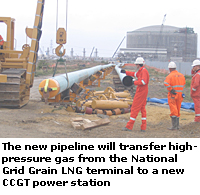Consultants STATS play key role in pipeline project
10/09/2008
 Leading environmental, engineering and materials consultancy STATS Ltd has recently completed work in preparation for the construction of a pipeline more than one mile in length to supply gas to a new £700m Combined Cycle Gas Turbine (CCGT) power station in Kent.
Leading environmental, engineering and materials consultancy STATS Ltd has recently completed work in preparation for the construction of a pipeline more than one mile in length to supply gas to a new £700m Combined Cycle Gas Turbine (CCGT) power station in Kent.STATS acted as specialist consultants to Stockton Drilling, who were commissioned by E.ON UK to investigate, design and construct the pipeline, which will transfer high-pressure gas from the National Grid Grain LNG (liquefied natural gas) terminal to a new power plant which will be constructed on the site of the existing Grain oil-fired power station.
Although the straight line distance between the Grain LNG and the power station site is only 2000 m, the two sites lie on opposite sides of the former Anglo Iranian oil refinery, which was constructed in the 1950s and decommissioned in the 1980s. Previous studies had identified a number of preferred route corridors, all of which presented very significant technological, ecological, environmental and geotechnical constraints which the design build contractor would have to overcome. These included heavily contaminated ground with highly sensitive receptors, numerous deep buried foundations, active and very highly sensitive LNG facilities and tight physical constraints with limited stringing areas.
Extensive unrecorded active and disused underground services and near-surface buried obstructions presented further challenges in addition to numerous planning conditions relating to environmental issues, archaeology, dust, noise and traffic.
As specialist consultants to Stockton Drilling, STATS were initially required to carry out a wide range of site surveys, including geotechnical and environmental investigations, geophysical surveys and feasibility studies. The results of these surveys identified a relatively simple geological profile comprising made ground, over very soft alluvium overlying River Terrace Deposits over London Clay.
However, the ground was locally heavily contaminated, primarily with asbestos and hydrocarbons, and although decommissioning had removed most of the above ground structures, STATS found that the poor ground conditions had resulted in piled foundations to practically every structure, even lightweight box culvert pipe bridges. The geophysical surveys also identified numerous buried services and unidentified obstructions, some of which were potentially UXB/UXO (unexploded bomb/ordnance).